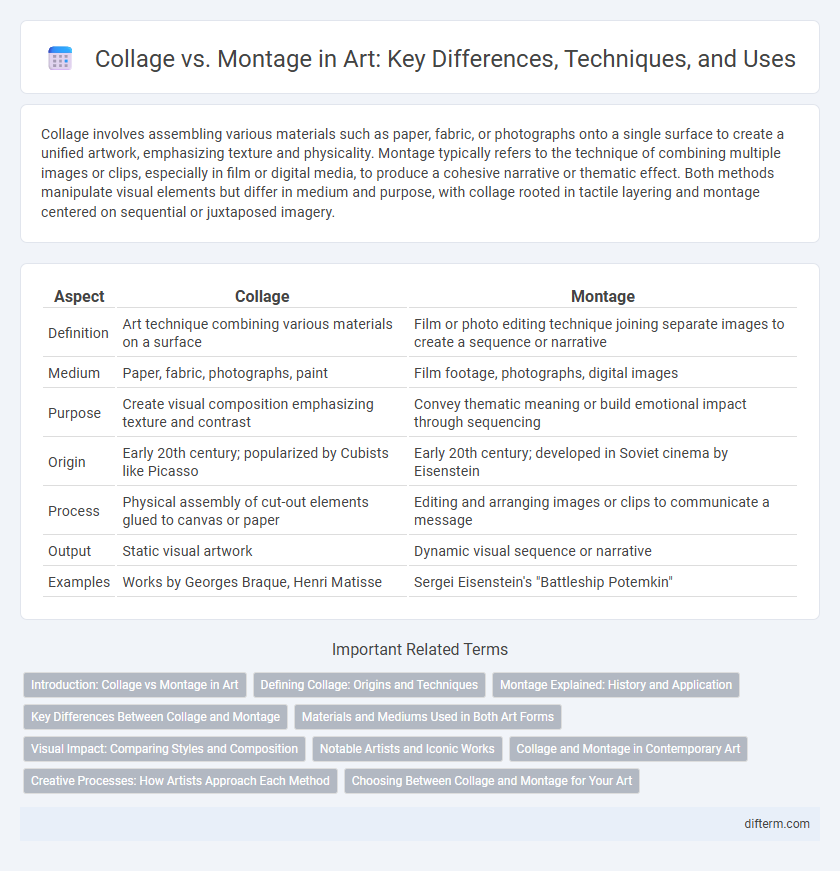Collage involves assembling various materials such as paper, fabric, or photographs onto a single surface to create a unified artwork, emphasizing texture and physicality. Montage typically refers to the technique of combining multiple images or clips, especially in film or digital media, to produce a cohesive narrative or thematic effect. Both methods manipulate visual elements but differ in medium and purpose, with collage rooted in tactile layering and montage centered on sequential or juxtaposed imagery.
Table of Comparison
| Aspect | Collage | Montage |
|---|---|---|
| Definition | Art technique combining various materials on a surface | Film or photo editing technique joining separate images to create a sequence or narrative |
| Medium | Paper, fabric, photographs, paint | Film footage, photographs, digital images |
| Purpose | Create visual composition emphasizing texture and contrast | Convey thematic meaning or build emotional impact through sequencing |
| Origin | Early 20th century; popularized by Cubists like Picasso | Early 20th century; developed in Soviet cinema by Eisenstein |
| Process | Physical assembly of cut-out elements glued to canvas or paper | Editing and arranging images or clips to communicate a message |
| Output | Static visual artwork | Dynamic visual sequence or narrative |
| Examples | Works by Georges Braque, Henri Matisse | Sergei Eisenstein's "Battleship Potemkin" |
Introduction: Collage vs Montage in Art
Collage and montage are distinct artistic techniques that combine various elements to create new compositions, with collage involving the assembly of different materials like paper, photographs, and fabric onto a surface. Montage, primarily used in film and photography, refers to the rapid sequencing of images or clips to produce a unified narrative or conceptual message. Both methods emphasize juxtaposition and transformation but serve different aesthetic and communicative purposes in visual art.
Defining Collage: Origins and Techniques
Collage, originating from the French word "coller" meaning "to glue," is an art technique that involves assembling various materials such as paper, fabric, and photographs onto a surface to create a new composition. Pioneered by artists like Pablo Picasso and Georges Braque in the early 20th century, collage emphasizes layering and texture to convey visual narratives or abstract concepts. Techniques include decoupage, photomontage integration, and mixed media applications that combine traditional and unconventional elements for dynamic artistic expression.
Montage Explained: History and Application
Montage is a filmmaking and artistic technique that assembles separate images or scenes to create a composite narrative, originating from Soviet cinema in the 1920s with pioneers like Sergei Eisenstein. It emphasizes juxtaposition and sequential editing to generate emotional or intellectual responses, transforming individual shots into a cohesive story or concept. Montage remains fundamental in contemporary art and media, influencing video art, advertising, and digital storytelling.
Key Differences Between Collage and Montage
Collage involves assembling various materials such as paper, fabric, or photographs onto a surface to create a unified artwork, emphasizing texture and tangible layers. Montage typically refers to the technique of combining multiple images or film clips in sequence or overlay to convey a specific theme or narrative. While collage focuses on physical composition and mixed media, montage emphasizes temporal or visual juxtaposition to enhance storytelling.
Materials and Mediums Used in Both Art Forms
Collage uses diverse materials such as paper, fabric, photographs, and found objects glued onto a surface, emphasizing texture and layered composition. Montage primarily involves the assembly of photographic or film strips, digitally or manually edited to create a cohesive visual narrative through overlapping images. Both art forms exploit mixed media, but collage favors tactile elements while montage centers on visual sequencing and manipulation.
Visual Impact: Comparing Styles and Composition
Collage emphasizes layering diverse materials and textures to create a tactile and fragmented visual impact that invites viewers to explore individual elements and their relationships. Montage relies on the precise sequencing and juxtaposition of images or frames to generate dynamic narrative flow and emotional resonance within a cohesive composition. Both techniques manipulate space and form differently, resulting in distinct visual rhythms and viewer engagement strategies.
Notable Artists and Iconic Works
Collage techniques were prominently utilized by Pablo Picasso in "Still Life with Chair Caning" and Georges Braque in "Violin and Candlestick," blending everyday materials to challenge traditional art forms. Montage, integral to Soviet filmmaker Sergei Eisenstein's work like "Battleship Potemkin," combined multiple images to convey powerful political narratives and emotional impact. Both methods revolutionized 20th-century art by altering composition and narrative through fragmented yet cohesive visuals.
Collage and Montage in Contemporary Art
Collage in contemporary art involves assembling diverse materials like paper, fabric, and photographs to create layered, textured compositions that challenge traditional narratives and emphasize fragmentation. Montage employs the juxtaposition of images or clips, often digital, to construct new meanings through contrast and sequence within multimedia artworks. Both techniques redefine visual storytelling by integrating disparate elements, highlighting the fluidity and hybridity characteristic of modern artistic expression.
Creative Processes: How Artists Approach Each Method
Artists engaging in collage assemble diverse materials such as paper, fabric, and photographs to create textured, multi-layered compositions that emphasize juxtaposition and tactile depth. Montage involves combining multiple images or video clips, often in film or digital media, to construct a unified narrative or thematic sequence through precise editing and synchronization. Both methods demand distinct creative processes: collage relies on physical manipulation and spontaneous arrangement, while montage emphasizes temporal coherence and conceptual integration.
Choosing Between Collage and Montage for Your Art
Choosing between collage and montage for your art depends on the desired visual impact and thematic complexity. Collage assembles diverse materials and textures to create layered, tactile compositions, ideal for expressive, mixed-media storytelling. Montage integrates multiple photographic or video images, emphasizing narrative sequence and conceptual juxtaposition, making it perfect for dynamic, time-based artworks.
Collage vs Montage Infographic

 difterm.com
difterm.com